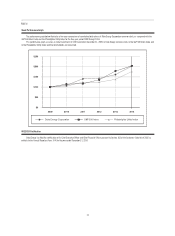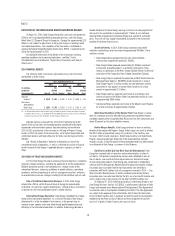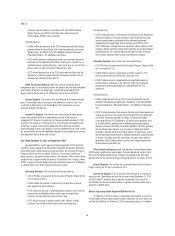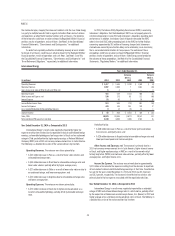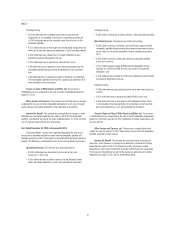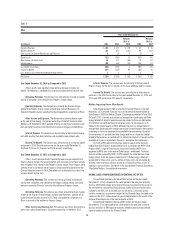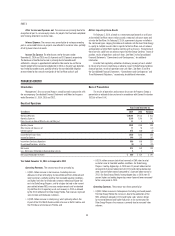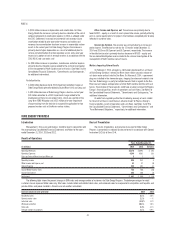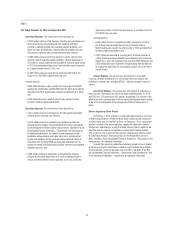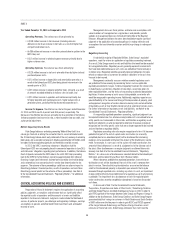Duke Energy 2014 Annual Report Download - page 57
Download and view the complete annual report
Please find page 57 of the 2014 Duke Energy annual report below. You can navigate through the pages in the report by either clicking on the pages listed below, or by using the keyword search tool below to find specific information within the annual report.
37
PART II
Partially offset by:
• An $18 million decrease in depreciation driven by discontinued
amortization of an intangible asset that was impaired and written off
in 2014 and extensions on the projected useful lives of assets in the
renewable portfolio;
• A $17 million decrease in fuel expense for the Beckjord station driven by
lower cost of coal from decreased production as units have been retired;
• A $16 million decrease related to a 2013 legal settlement reserve
related to previously disposed businesses;
• A $10 million decrease in general and administrative costs;
• A $9 million decrease in operations and maintenance expense for the
renewables portfolio driven primarily by development cost reductions;
and
• A $6 million decrease in property tax expense driven by cost reductions
in the renewables portfolio resulting from a property tax abatement that
went into effect in the current year.
Losses on Sales of Other Assets and Other, net. The variance is
attributable to a loss recognized on the sale of certain renewable development
projects in 2013.
Other Income and Expense. The variance was primarily due to a net gain
recognized for the sale of certain renewable development assets and increased
equity earnings from higher production in the renewable wind portfolio.
Income Tax Benefi t. The variance was primarily due to changes in state
deferred taxes and higher production tax credits in 2014 for the Renewables
portfolio. The effective tax rate for the years ended December 31, 2014 and 2013
was 75.5 percent and 62.8 percent, respectively.
Year Ended December 31, 2013 as Compared to 2012
Commercial Power’s results were negatively impacted by the sale of non-
core business operations and lower income from the renewables portfolio and
Beckjord generating station. These impacts are partially offset by higher income tax
benefi ts. The following is a detailed discussion of the variance drivers by line item.
Operating Revenues. The variance was driven primarily by:
• An $81 million decrease due primarily to the sale of non-core
businesses in 2012; and
• A $35 million decrease in electric revenues for the Beckjord station
driven from lower production as units were prepared for retirement.
Partially offset by:
• A $67 million increase due to higher volumes in the renewables portfolio.
Operating Expenses. The variance was driven primarily by:
• A $34 million increase in operations and maintenance expense for the
renewables portfolio driven primarily by commercial operation of certain
assets and costs to run the renewables services company acquired in
2012;
• A $25 million increase in depreciation driven by renewable portfolio
assets put in service;
• A $17 million increase related to Midcontinent Independent System
Operator, Inc. (MISO) and PJM Transmission System Enhancement
obligations; and
• A $16 million increase related to a 2013 legal settlement reserve related
to previously disposed businesses.
Partially offset by:
• A $56 million decrease due primarily to the sale of non-core businesses
in 2012;
• A $17 million decrease in general and administrative costs; and
• A $16 million decrease in fuel expense for the Beckjord station, which
is not included in the Disposal Group, driven by lower cost of coal from
decreased production as units were prepared for retirement.
(Losses) Gains on Sales of Other Assets and Other, net. The variance
is attributable to a loss recognized on the sale of certain renewable development
projects in 2013 and a gain on the 2012 contribution of certain renewable assets
to a joint venture.
Other Income and Expense, net. The variance is primarily due to the
sale of non-core businesses in 2012, lower equity earnings from the renewables
portfolio, and lower interest income.
Income Tax Benefi t. The variance was primarily due to an increase in
pretax loss and a decrease in manufacturing deductions combined with higher
production tax credits in 2013. The effective tax rates for the years ended
December 31, 2013 and 2012 were 62.8 percent and 58.4 percent, respectively.
The increase in the effective tax rate for the period was primarily due to higher
production tax credits in 2013 for the renewable portfolio.


